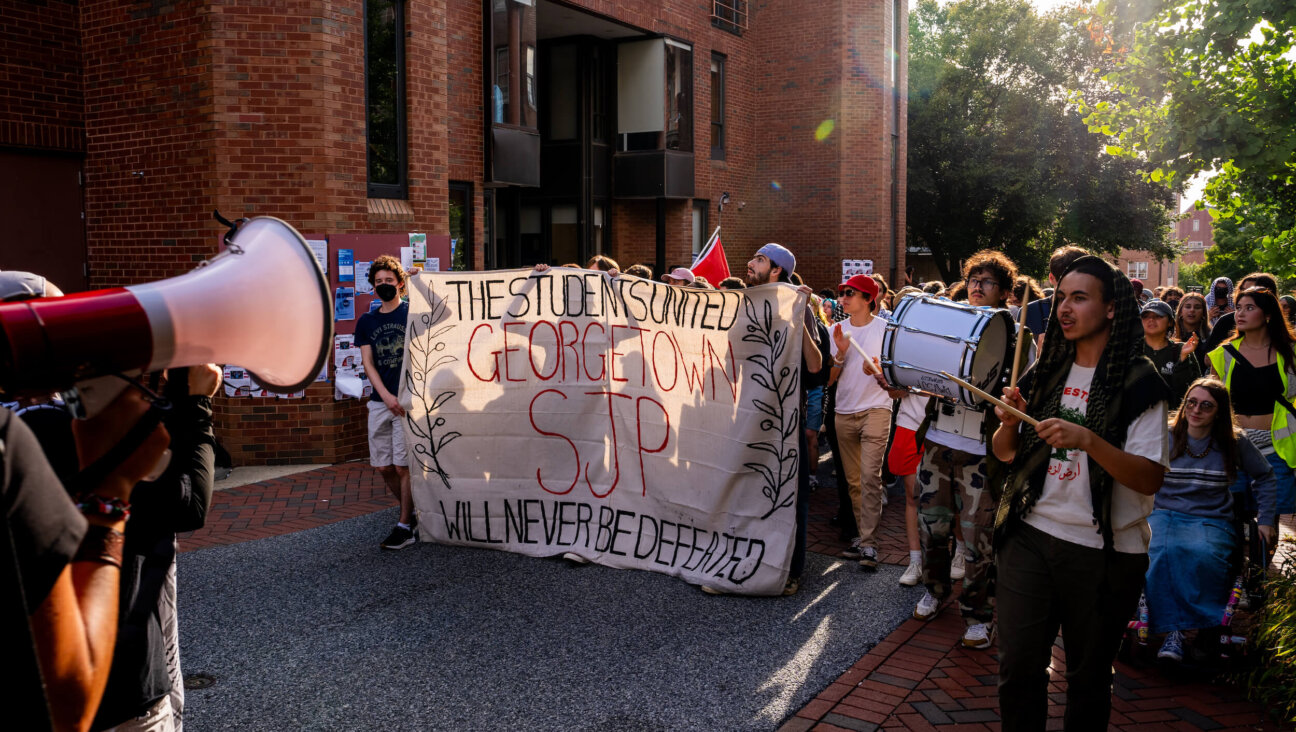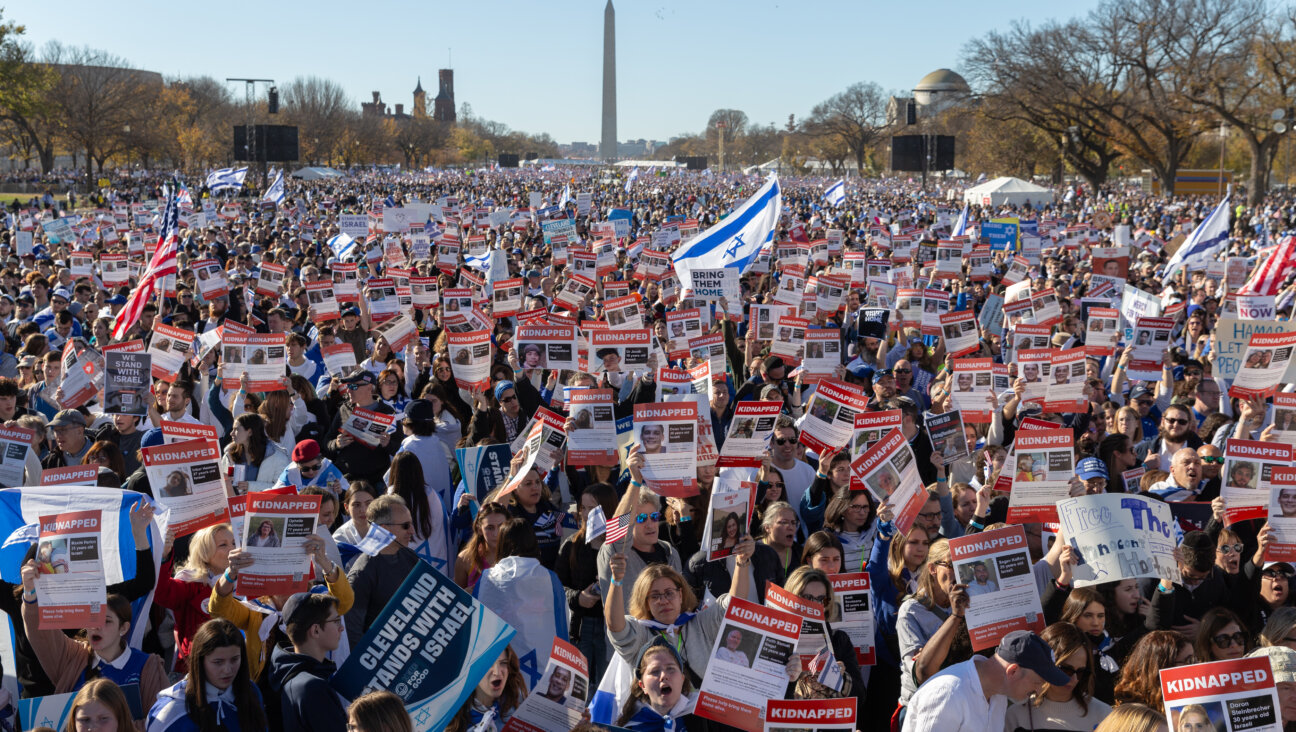Hassan Nasrallah was not a ‘towering leader’ — he was a terrorist
Descriptions of the slain Hezbollah leader conveniently leave out the fact that he was responsible for the murders of thousands of civilians

A banner bearing a picture of slain Lebanese Hezbollah leader Hassan Nasrallah hangs in central Tehran. Photo by Getty
I was driving on Lake Shore Drive in Chicago when I heard Hassan Nasrallah of Hezbollah described on National Public Radio as “this towering figure and leader.”
“So what kind of response do you expect from Hezbollah to the killing of Nasrallah, this towering figure and leader?” host Ayesha Rascoe asked Mohamad Bazzi, the director of the Center for Near Eastern Studies at New York University.
I nearly swerved into the next lane.
Towering figure? Leader?
Well, maybe to the Supreme Leader of Iran.
Hezbollah, or the “party of God,” was formed in 1982 by Iran’s Islamic Revolutionary Guard Corps, with the goal of removing the Israeli troops then in Lebanon. In 1983 and 1984, Hezbollah’s suicide truck bombings killed nearly 300 Americans and Lebanese; by 1985, it was into hijacking planes. The passengers were — oh yes — civilians.
I felt like the history of Hezbollah was being transformed and renamed.
Would anyone bother to check actual U.S. government records on Hezbollah and TWA Flight 847, which was hijacked on June 14, 1985 by terrorists “brandishing grenades and pistols during a routine flight from Athens to Rome.”
“Over a horrific 17 days,” the FBI noted, “TWA pilot John Testrake was forced to crisscross the Mediterranean with his 153 passengers and crew members, from Beirut to Algiers and back again, landing in Beirut three times before he was finally allowed to stop. The terrorists had tied passengers up and were beating them, threatening to kill them unless hundreds of Lebanese were released from Israeli prisons.”
I remember when Hezbollah crossed the border and kidnapped three Israeli soldiers on Oct. 7, 2000, and then plastered huge posters of their faces to the mountains that could be seen from Metullah, a picturesque town at Israel’s northern border. Those faces will stay with me forever. So, too, will the memory that one of those soldiers was Druze; two were Jewish.
More recently, Hezbollah sent its fighters into Syria to help another “towering figure,” Syrian President Bashar al-Assad, responsible for the deaths of at least a half million of his own people and the displacement of millions, including more than 750,000 Syrian refugees now in Lebanon, a fact which is mentioned far too rarely, if at all.
Hezbollah has also helped Iran’s militia allies in Yemen and Iraq.
And of course, ever since Oct. 7, Hezbollah has been raining rockets on Israel in support of its friend, Hamas. Those rockets have displaced over 60,000 Israelis from their homes.
There were a few words missing from Rascoe’s description of Nasrallah.
“Terrorist” was one. And what about “murderer of Americans?” Since when does that make someone a “towering figure?”
I forced myself to keep listening.
“I mean, the killing of Nasrallah was a huge escalation and a huge event, but this past Monday, dozens of Israeli warplanes started bombing targets across Lebanon,” Bazzi told Rascoe on NPR. “They killed more than 550 people, injured almost 1,800 people within several hours. And so that was one of the most intense aerial bombardments in modern history. And that, I think, marked the day when Israel expanded the Gaza war into Lebanon.”
I doubted that this was “one of the most intense aerial bombardments in modern history,” though I suppose it depends where “modern history” begins. Would that include World War II, Vietnam, or maybe, what Putin did in Mariupol? There was no other guest to comment, or debate what “modern history” might mean, just as there was no one to push back on the description of Nasrallah — Nasrallah! — as a “towering figure and leader,” with zero context.
When I got out of the car, I decided to see what The White House had to say. It issued this statement from President Joe Biden, who pointed out that “Hassan Nasrallah and the terrorist group he led, Hezbollah, were responsible for killing hundreds of Americans over a four-decade reign of terror. His death from an Israeli airstrike is a measure of justice for his many victims, including thousands of Americans, Israelis, and Lebanese civilians.”
Reading Biden’s statement, I realized that the word “terrorist” was what was missing from so many news reports — Hezbollah is part of the trend that erases the word “terrorist” in the name of objectivity. This is also why we rarely hear what Hamas members actually believe in.
While what Project 2025 has to say is something journalists feel comfortable quoting, and every statement by far-right Israeli leaders is amplified, actual Hezbollah statements — and Hamas charters — get far less play, and Hezbollah is often referred to as an “armed group” rather than a terrorist organization.
Interestingly, CNN refers to Hezbollah as “the Iran-backed militant group,” which says more than most outlets do, and calls attention to two facts that many fawning commentators seemed to forget — that Hezbollah is funded by Iran and uses weapons.
When I tried to figure out where the “towering figure” language on NPR came from, I found an article in New Lines magazine, in which Hassan Hassan and Kareem Shaheen describe Nasrallah, Osama bin Laden, and Iranian General Qassem Soleimani as “towering figures who have shaped the region’s violent modern history.”
“Nasrallah, however, was more than just an operator,” the article states. “He was the model, the blueprint. The Hezbollah leader’s charisma and his ability to fuse the roles of military commander, political leader and cultural icon placed him in a different league.”
“He did not merely work within a system; he helped to create it,” the article’s authors go on to say. “Hezbollah was a grassroots movement, nurtured by Iran but built on the ground in Lebanon, and Nasrallah shaped it into a formidable force capable of challenging Israel and shaping the course of conflicts across the region.”
For those with short memories, it’s worth noting that the “towering figure” with “charisma” who led a “grassroots movement” that was “nurtured by Iran” had miserable things to say about Jews in general — not just Israelis.
“Nasrallah praised Holocaust deniers and in 2001 reportedly called Jews “miserly and cowardly,” The Guardian noted.
Of all the obituaries I read, the one in The Guardian was the only one that mentioned Hezbollah’s murder of Argentinian Jews, an event seared in the memory of many from the tight-knit Jewish community in Buenos Aires, who still mention it in conversation.
The truth is that Hassan Nasrallah was charismatic, as multiple obituaries pointed out. And he had significant influence in the region.But some of the glowing language describing him neglects to mention his raison d’être — the destruction of Israel. It also conveniently omits Hezbollah’s repeated murders of Americans and Jews around the world, along with the suffering he brought to many Lebanese civilians.
The average driver listening on the radio can’t figure that out if the kidnappings, barracks bombings, and the recent rocket fire on Druze children playing in soccer fields are never mentioned. Maybe we should reserve “towering figure” for those who contribute to art, science and peace.
A message from our Publisher & CEO Rachel Fishman Feddersen

I hope you appreciated this article. Before you go, I’d like to ask you to please support the Forward’s award-winning, nonprofit journalism so that we can be prepared for whatever news 2025 brings.
At a time when other newsrooms are closing or cutting back, the Forward has removed its paywall and invested additional resources to report on the ground from Israel and around the U.S. on the impact of the war, rising antisemitism and polarized discourse.
Readers like you make it all possible. Support our work by becoming a Forward Member and connect with our journalism and your community.
— Rachel Fishman Feddersen, Publisher and CEO






























